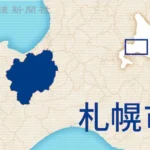Around 11:30 AM on October 17, 2025, a passerby discovered that the door of a salmon fry hatchery facility in Atsuta, Atsuta Ward, Ishikari City was broken.
The building was a single-story wooden structure that served as a storage shed for fry feed.
The person who made the discovery contacted the fisheries cooperative, and while municipal officials were inspecting the site, a patrolling police officer came across the scene and assessed the situation.
The door, which had a glass upper half and was missing its lower half, appeared to have been broken through by the bear to enter the shed.
Clear bear paw prints were found on the remaining glass portion, and multiple bags of fry feed stored inside were torn open with signs that the feed had been eaten.
The shed had been unoccupied since June of this year, and it is unclear exactly when the bear entered.
Police are maintaining vigilance through continued patrols of the surrounding area.
Atsuta Ward
Atsuta Ward is a district in Nagoya, Japan, renowned for housing the Atsuta Shrine, one of Shinto’s most significant shrines. Founded almost 2,000 years ago, it is traditionally believed to enshrine the sacred Kusanagi no Tsurugi sword, one of the Imperial Regalia of Japan. The shrine and its surrounding area have been a major center of worship and a focal point of Japanese culture for centuries.
Ishikari City
Ishikari City is a coastal city located in Hokkaido, Japan, on the Ishikari Bay. Historically, it developed as a key fishing port, particularly known for its snow crab, and its name is derived from the indigenous Ainu language. In the modern era, it has also become known for its offshore wind farms, contributing to renewable energy in the region.
salmon fry hatchery facility
A salmon fry hatchery facility is a human-managed operation designed to support salmon populations by artificially incubating eggs and raising the young fish (fry). This practice began to counteract the impacts of habitat loss, overfishing, and dams, helping to ensure the species’ survival. The hatchery-reared fry are eventually released into rivers to migrate to the ocean, bolstering wild stocks for both ecological health and commercial fisheries.
fisheries cooperative
A fisheries cooperative is a community-based organization formed by fishermen to collectively manage resources, market their catch, and purchase supplies. Historically, these cooperatives emerged to give small-scale fishers more economic power and to promote sustainable fishing practices. They play a vital role in supporting the livelihoods of local fishing communities.






